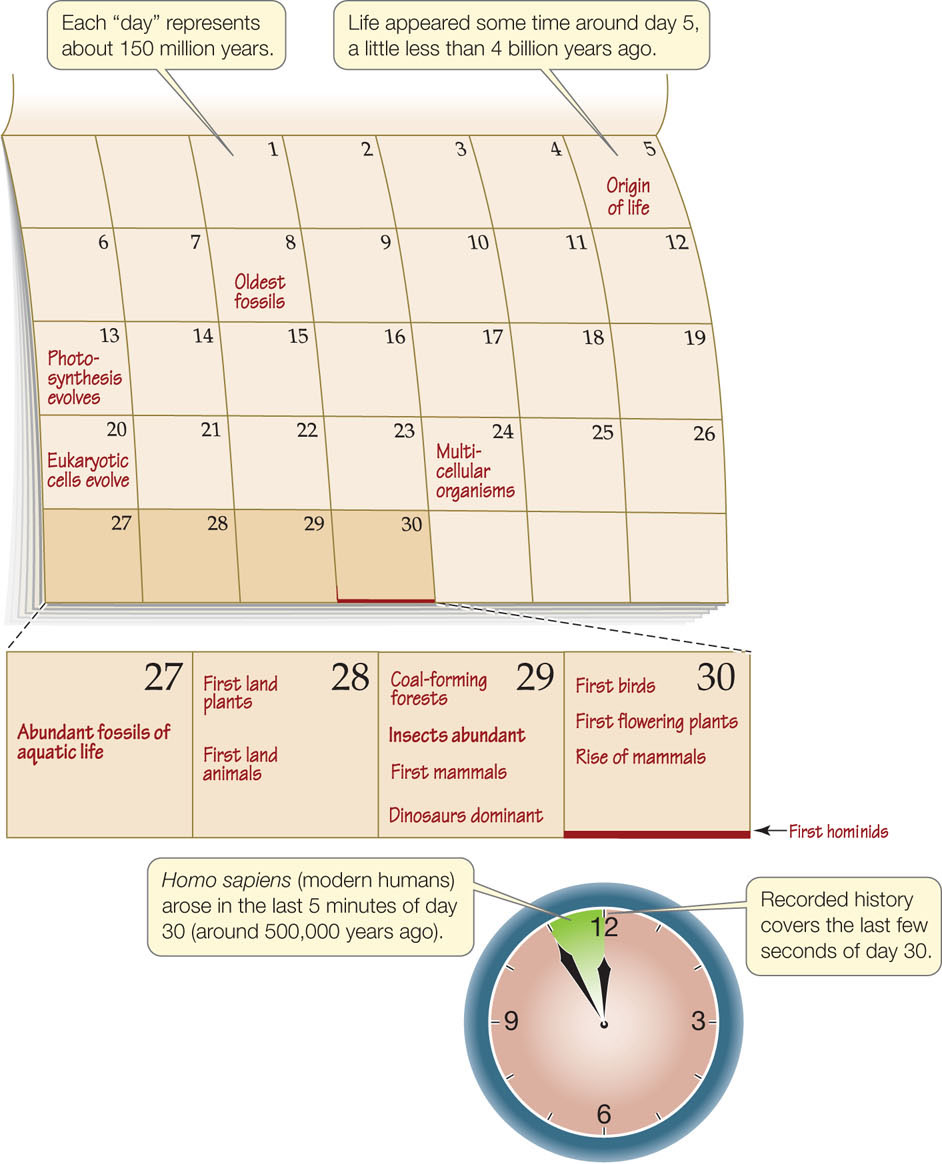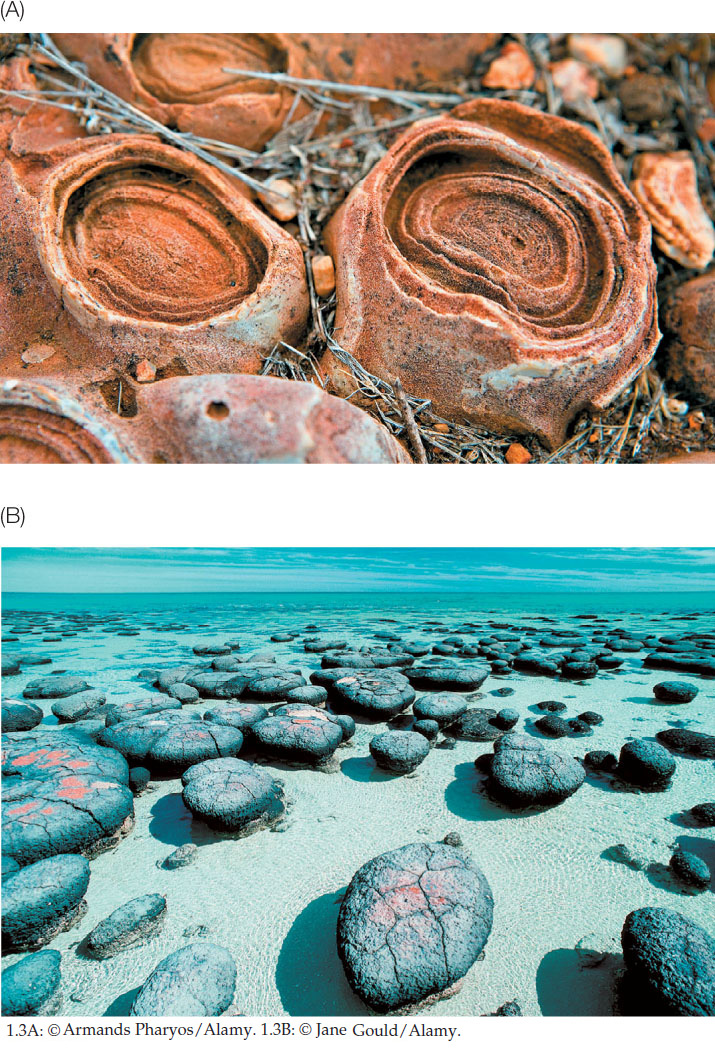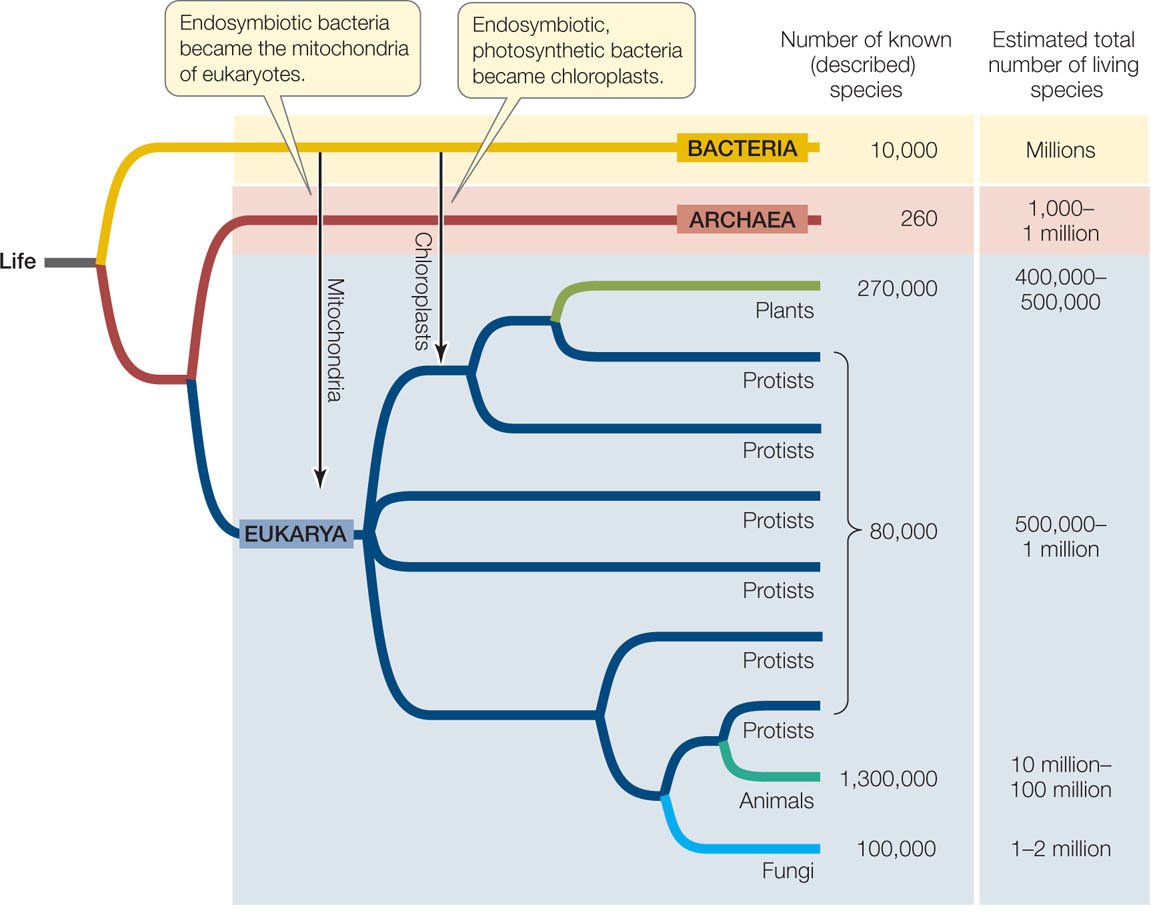Concept 1.1: Living Organisms Share Common Aspects of Structure, Function, and Energy Flow
Biology is the scientific study of life, which encompasses all living things, or organisms. The living things we know about are all descended from a single-celled ancestor that lived on Earth almost 4 billion years ago. We can imagine that something with some similarities to life as we know it might have originated differently, perhaps on other planets. But the evidence suggests that all of life on Earth today has a single origin—a single common ancestor—and we consider all the organisms that descended from that common ancestor to be a part of life.
Life as we know it had a single origin
The overwhelming evidence for the common ancestry of life lies in the many characteristics that are shared among living organisms. Typically, living organisms
- are composed of a common set of chemical parts, such as nucleic acids (one example is DNA, which is the important molecule that carries our genetic information) and amino acids (the chemical building blocks that make up proteins), and similar structures, such as cells enclosed within membranes
- depend on intricate interactions among structurally complex parts to maintain the living state
- contain genetic information that uses a nearly universal code to specify how proteins are assembled
- convert molecules obtained from their environment into new biological molecules
- extract energy from the environment and use it to carry out life functions
- replicate their genetic information in the same manner when reproducing themselves
- share structural similarities among a fundamental set of genes
- evolve through gradual changes in their genetic information
Taken together, these shared characteristics logically lead to the conclusion that all life has a common ancestry, and that the diverse organisms that exist today originated from one life form. If life had multiple origins, there would be little reason to expect a nearly universal genetic code, or the similarities among many genes, or a common set of amino acids. If we were to discover something similar to life, such as a self-replicating system that originated independently on another planet, we would expect it to be fundamentally different in these aspects. It might be similar in some ways to life on Earth, such as using genetic information to reproduce. But we would not expect the details of its genetic code, for example, to be like ours.
The simple list of shared characteristics above, however, does not describe the incredible complexity and diversity of life. Some forms of life may not even display all of these characteristics all of the time. For example, the seed of a desert plant may exist for many years in a dormant state in which it doesn’t extract energy from the environment, convert molecules, or reproduce. Yet the seed is alive.
And then there are viruses, which are not composed of cells and cannot carry out physiological functions on their own. Instead they use the cells they invade to perform these functions for them. Yet viruses contain genetic information, and they mutate and evolve. So even though viruses are not independent cellular organisms, their existence depends on cells, and there is strong evidence that viruses evolved from cellular life forms. For these reasons, most biologists consider viruses to be a part of life. But as viruses illustrate, the boundaries between “living” and “nonliving” are not always clear, and all biologists do not agree exactly on where we should draw the lines.
Major steps in the history of life are compatible with known physical and chemical processes
Geologists estimate that Earth formed between 4.6 and 4.5 billion years ago. At first the planet was not a very hospitable place. It was some 600 million years or more before the earliest life evolved. If we picture the history of Earth as a 30-day month, with each day representing about 150 million years, life first appeared somewhere toward the end of the first week (FIGURE 1.1).

How might life have arisen from nonliving matter? In thinking about this question, we must take into account that the young Earth’s atmosphere, oceans, and climate all were very different than they are today. Biologists have conducted many experiments that simulate the conditions on early Earth. These experiments have confirmed that the formation of complex organic molecules under such conditions is possible, even probable.
The critical step for the evolution of life, however, was the appearance of nucleic acids—molecules that could reproduce themselves and also contain the information for the synthesis, or manufacture, of large molecules with complex but stable shapes. These large, complex molecules were proteins. Their shapes varied enough to enable them to participate in increasing numbers and kinds of chemical reactions with other molecules.
Cellular Structure Evolved In The Common Ancestor Of Life
In the next big step in the origin of life, a membrane surrounded and enclosed complex proteins and other biological molecules, forming a tiny cell. This membrane kept the enclosed components separate from the surrounding external environment. Molecules called fatty acids played a critical role because these molecules form membrane-like films instead of dissolving in water. When agitated, these films can form hollow spheres, which could have enveloped assemblages of biological molecules. The creation of a cell interior, separate from the external environment, allowed the reactants and products of chemical reactions to be concentrated, opening up the possibility that those reactions could be integrated and controlled. This natural process of membrane formation likely resulted in the first cells with the ability to reproduce—the evolution of the first cellular organisms.
3
For more than 2 billion years after cells originated, every organism consisted of only one cell. These first organisms were prokaryotes, which are made up of single cells containing genetic material and other biochemical structures enclosed in a membrane (FIGURE 1.2). Vast numbers of their descendants, such as bacteria, exist in similar form today. Early prokaryotes were confined to the oceans, which had an abundance of complex molecules they could use as raw materials and sources of energy. The oceans also shielded them from the damaging effects of ultraviolet (UV) light, which was intense at that time because there was little or no oxygen (O2) in the atmosphere, and for that reason, no protective ozone (O3) layer in the upper atmosphere.

Photosynthesis Allowed Living Organisms To Capture the Sun’s Energy
To fuel the chemical reactions inside them, the earliest prokaryotes took in molecules directly from their environment and broke down these small molecules to release and use the energy contained in their chemical bonds. Many modern prokaryotes still function this way, and very successfully.
About 2.7 billion years ago, or on day 13 of our imaginary month-long calendar of life, the emergence of photosynthesis changed the nature of life on Earth (see Figure 1.1). Photosynthesis is a set of chemical reactions that transforms the energy of sunlight into chemical-bond energy of the sugar glucose and other relatively small biological molecules. In turn, the chemical-bond energy of these small molecules can be tapped to power other chemical reactions inside cells, including the synthesis of large molecules, such as proteins, that are the building blocks of cells.
Photosynthesis is the basis of much of life on Earth today because its energy-capturing processes provide food for other organisms. Photosynthetic organisms use solar energy to build their tissues, and then other organisms use those tissues as food. Early photosynthetic cells were probably similar to the present-day prokaryotes called cyanobacteria (FIGURE 1.3). Over time, photosynthetic prokaryotes became so abundant that they produced vast quantities of O2 as a by-product of photosynthesis.

During the early eons of life on Earth, there was no O2 in the atmosphere. In fact, O2 was poisonous to many of the prokaryotes that lived at that time. But those organisms that tolerated O2 were able to proliferate as O2 slowly began to accumulate in the atmosphere. The presence of O2 opened up vast new avenues of evolution. Aerobic metabolism, a set of chemical reactions that releases energy from life’s molecules by using O2, proved to be more efficient than anaerobic metabolism, a set of reactions that extracts energy without using O2. For this reason, O2 allowed organisms to live more intensely and grow larger. The majority of living organisms today use O2 in extracting energy from molecules.
4
Oxygen in the atmosphere also made it possible for life to move onto land. For most of life’s history, UV radiation falling on Earth’s surface was so intense that it destroyed any living cell that was not well shielded by water. But as a result of photosynthesis, O2 accumulated in the atmosphere for more than 2 billion years and gradually resulted in a layer of ozone in the upper atmosphere. By about 500 million years ago, or about day 28 on our imaginary calendar of life, the ozone layer was sufficiently dense and absorbed enough of the sun’s UV radiation to make it possible for organisms to leave the protection of the water and live on land (see Figure 1.1).
Eukaryotic Cells Arose Through Endosymbiosis
Another important, earlier step in the history of life was the evolution of cells with membrane-enclosed compartments called organelles. Organelles were—and are—important because specialized cellular functions could be performed inside them, separated from the rest of the cell. The first organelles probably appeared about 2.5 billion years after life first appeared on Earth, or about day 20 on Figure 1.1.
One of these organelles, the nucleus, came to contain the cell’s genetic information. The nucleus (Latin nux, “nut” or “core”) gives these cells their name: eukaryotes (Greek eu, “true”; karyon, “kernel” or “core”). The eukaryotic cell is distinct from the cells of prokaryotes (pro, “before”), which lack nuclei and other internal compartments.
Some organelles are hypothesized to have originated by endosymbiosis, which means “living inside another” and may have occurred when larger cells ingested smaller ones. The mitochondria that release energy for use by a eukaryotic cell probably evolved from engulfed prokaryotic organisms. And chloroplasts—the organelles specialized to conduct photosynthesis in eukaryotic photosynthetic organisms—could have originated when larger eukaryotes ingested photosynthetic prokaryotes. If the larger cell failed to break down this intended food object, a partnership could have evolved in which the ingested prokaryote provided sugars from photosynthesis and the host cell provided a good environment for its smaller partner.
Multicellularity Allowed Specialization of Tissues and Functions
For the first few billion years of life, all organisms—whether prokaryotic or eukaryotic—were single-celled. At some point, the cells of some eukaryotes failed to separate after cell division and remained attached to each other. These groupings of cells made it possible for some cells in the group to specialize in certain functions, such as reproduction, while other cells specialized in other functions, such as absorbing nutrients. Cellular specialization enabled multicellular eukaryotes to increase in size and become more efficient at gathering resources and living in specific environments.
Biologists can trace the evolutionary tree of life
If all the organisms on Earth today are the descendants of a single kind of unicellular organism that lived almost 4 billion years ago, how have they become so different? An organism reproduces by replicating its genome, which is the sum total of its genetic material, as we will discuss shortly. This replication process is not perfect, however, and changes, called mutations, are introduced almost every time a genome is replicated. Some mutations give rise to structural and functional changes in organisms. As individuals mate with one another, these changes can spread within a population, but the population continues to be made up of one kind, or species, of organism. However, if something happens to isolate some members of a population from the others, structural and functional differences between the two groups will accumulate over time. The two groups may eventually differ enough that their members no longer regularly reproduce with one another. In this way the two populations become two different species.
Tens of millions of species exist on Earth today. Many times that number lived in the past but are now extinct. As biologists discover species, they give each one a scientific name called a binomial (because it is made up of two Latinized words). The first word identifies the species’ genus—a group of species that share a recent common ancestor. The second word indicates the species. For example, the scientific name for the human species is Homo sapiens: Homo is our genus and sapiens our species. Homo is Latin for “man,” and sapiens is from the Latin word for “wise” or “rational.” Our closest relatives in the genus Homo are the Neanderthals (Homo neanderthalensis), which are now extinct and are known only from fossil remains.
5
Much of biology is based on comparisons among species. Our ability to make relevant comparisons has improved greatly in recent decades as a result of our relatively newfound ability to study and compare the genomes of different species. We do this by sequencing a genome (in whole or in part), which means we can determine the order of the nucleotides that serve as the building blocks of the organism’s DNA. Genome sequencing and other molecular techniques have allowed biologists to add a vast array of molecular evidence to existing evolutionary knowledge based on the fossil record. The result is the ongoing compilation of phylogenetic trees that document and diagram evolutionary relationships as part of an overarching tree of life. The broadest categories of this tree are shown in FIGURE 1.4. (The tree is expanded in Appendix A, and you can also explore the tree interactively online.)

Many details remain to be clarified, but the broad outlines of the tree of life have been determined. Its branching patterns are based on a rich array of evidence from fossils, structures, chemical processes, behavior, and molecular analyses of genomes. Molecular data in particular have been used to separate the tree into three major branches called domains: Archaea, Bacteria, and Eukarya. The organisms of each domain have been evolving separately from those in the other domains for more than a billion years. Note that all organisms that are alive today descended from common ancestors in the past. In other words, living species did not evolve from other species living today. Rather, all living organisms evolved from now-extinct common ancestors. For example, humans did not evolve from our close relatives, the chimpanzees, but humans and chimpanzees both evolved from a common (now extinct) ancestral species.
Organisms in the domains Archaea and Bacteria are single-celled prokaryotes. However, members of these two groups differ so fundamentally that they are thought to have separated into distinct evolutionary lineages very early. Species belonging to the third domain—Eukarya—have eukaryotic cells whose mitochondria and chloroplasts originated from endosymbioses with bacteria, as we have described.
Plants, fungi, and animals are examples of familiar multicellular eukaryotes. We know that multicellularity arose independently in each of these three multicellular groups because they are each most closely related to different groups of unicellular eukaryotes (commonly called protists), as you can see from the branching pattern of Figure 1.4.
Life’s unity allows discoveries in biology to be generalized
Knowledge gained from investigations of one kind of organism can, with care, be generalized to other organisms because all life is related by descent from a common ancestor, shares a genetic code, and consists of similar molecular building blocks. Biologists use certain model organisms for research, knowing they can extend their findings to other organisms, including humans.
6
Our basic understanding of the chemical reactions in cells came from research on bacteria but is applicable to all cells, including those of humans. Similarly, the biochemistry of photosynthesis—the process by which plants use sunlight to produce sugars—was largely worked out from experiments on Chlorella, a unicellular green alga. Much of what we know about the genes that control plant development is the result of work on Arabidopsis thaliana, a member of the mustard family. Knowledge about how animals develop has come from work on sea urchins, frogs, chickens, roundworms, and fruit flies. And recently, the discovery of a major gene controlling human skin color came from work on zebrafish. Being able to generalize from model systems is a powerful tool in biology.